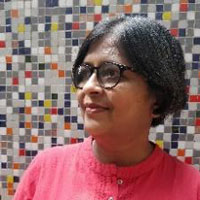Smita Dalvi
 This journal that we started in the year 2014, had articulated a vision of creating a space for academic research in architecture and built environment in such a way that this space opens up avenues for discursive practices through such writings. Disciplines such as architecture, urban design and planning can no longer be simply viewed as mechanistic outcomes that are self-contained. These are inexorably linked with people, culture, society and polity. The practice of design in past, present and future gets shaped through these filters and circumstances. There is a great value in uncovering these layers through discursive research practices to gain a better understanding of our world and a step towards improving it.
This journal that we started in the year 2014, had articulated a vision of creating a space for academic research in architecture and built environment in such a way that this space opens up avenues for discursive practices through such writings. Disciplines such as architecture, urban design and planning can no longer be simply viewed as mechanistic outcomes that are self-contained. These are inexorably linked with people, culture, society and polity. The practice of design in past, present and future gets shaped through these filters and circumstances. There is a great value in uncovering these layers through discursive research practices to gain a better understanding of our world and a step towards improving it.
This journal has always encouraged young and experienced researchers to explore the disciplines of architecture and design beyond the disciplinary boundaries, to uncover the layers of discourse as mentioned. In this issue of Tekton, the authors of papers and essays, each of them are attempting to do this in their own ways. They are either seeking social meanings of architecture through exploring it in popular culture or they are presenting deeply researched readings of public architecture/ landscapes created by the state to decipher political and social forces at play behind such acts of creation. They are presenting the readers with exciting methods and concepts to review architecture beyond the banal simplicities and thereby enriching the existing understanding of design process and outcomes.
In this issue of Tekton, we feature the following:
Mustansir Dalvi in his paper trace the rise of Gothic Revival architecture in Bombay of mid-19th century through a deep reading of its university buildings. He shows how an adapted Gothic deployed in these buildings foreground an imperial agenda on the part of the British rulers – which was to establish the British Empire in India and its complete dominance on the subject populations through the twin hegemonies of education and architecture.
Dhawal Jain in his essay has expressed liminality in Malawi, a small country in Africa, through an analysis of the ongoing social, cultural, and architectural developments in the country. Through this analysis, it further talks about the concept of Impact design, which is rooted in the belief that design can be used to create positive social, environmental, and economic change, and focuses on actively measuring impact to inform and direct the design process.
Nishant Modi in his essay views ‘Place’ a construct and argues that it can never be constructed anew, but can only be re-placed. A construct is defined not just by the material reality of the place but also by the thought and un-thought ‘Definitions and Memory’ of the place. The essay tries to expand on the idea of ‘Memory’ to enter the concept of Re-Place. The essay uses various place constructs to understand, perceive and conceptualize the idea of Place, Place production and Place meaning.
Smita Dalvi’s paper links the medium of cinema with architecture by focussing on Film Architecture to create a discursive method to analyse films from the point of view of spaces articulated in them. The paper analyses recent Hindi films that are remakes of Devdas, an iconic film of the fifties to draw readings on spectacle of space used as a stylistic device and its significatory role to convey ideas and themes in the narrative.
Amita Sinha in her paper creates an overview of parks in Lucknow as landscapes of commemoration and recreation, themes pertinent to current political agendas and ideas regarding functions of public spaces. She reviews the park building in the city since independence and analyses them in two distinct phases; commenting on the changing ideas about their functions as public places as put in place by different political ideologies in power. She critics their role as true civic spaces is questionable as is their sustainability.
Smita Dalvi
December, 2022.
smitadalvi@mes.ac.in

